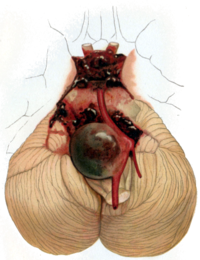
Photo from wikipedia
OBJECTIVE Microsurgery plays an essential role in managing unruptured intracranial aneurysms (UIAs). The Clavien-Dindo classification is a therapy-oriented grading system that rates any deviation from the normal postoperative course in… Click to show full abstract
OBJECTIVE Microsurgery plays an essential role in managing unruptured intracranial aneurysms (UIAs). The Clavien-Dindo classification is a therapy-oriented grading system that rates any deviation from the normal postoperative course in five grades. In this study, the authors aimed to test the applicability of the Clavien-Dindo grade (CDG) in patients who underwent microsurgical treatment of UIAs. METHODS The records of patients who underwent microsurgery for UIAs (January 2013-November 2018) were retrieved from a prospective database. Complications at discharge and at short-term follow-up (3 months) were rated according to the Clavien-Dindo system. Patient outcomes were graded using the modified Rankin Scale (mRS) and the National Institutes of Health Stroke Scale (NIHSS). A descriptive statistic was used for data analysis. RESULTS Overall, 156 patients underwent 157 surgeries for 201 UIAs (size range 4-42 mm). Thirty-nine patients (25%) had complex UIAs. An adverse event (CDG ≥ I) occurred in 21 patients (13.5%) by the time of discharge. Among these, 10 patients (6.4%) presented with a new neurological deficit. Significant correlations existed between a CDG ≥ I and an increase in mRS and NIHSS scores (p < 0.001). Patients treated for complex aneurysms had a significantly higher risk of developing new neurological deficits (20.5% vs 1.7%, p = 0.007). At the 3-month follow-up, a CDG ≥ I was registered in 16 patients (10.3%); none presented with a new neurological deficit. A CDG ≥ I was associated with a longer hospital length of stay (LOS) (no complication vs CDG ≥ I, 6.2 ± 3.5 days vs 9.3 ± 7.7 days, p = 0.02). CONCLUSIONS The CDG was applicable to patients who received microsurgery of UIAs. A significant correlation existed between CDG and outcome scales, as well as LOS. The aneurysm complexity was significantly associated with a higher risk for new neurological deficit.
Journal Title: Neurosurgical focus
Year Published: 2021
Link to full text (if available)
Share on Social Media: Sign Up to like & get
recommendations!